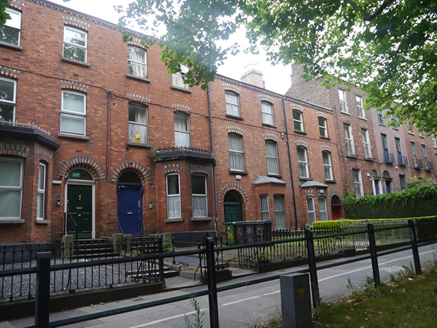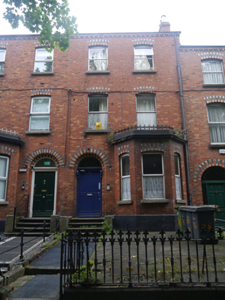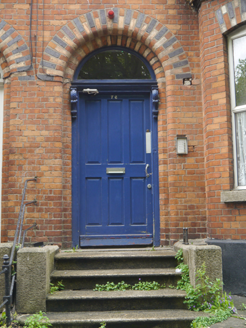Survey Data
Reg No
50130184
Rating
Regional
Categories of Special Interest
Architectural, Artistic
Original Use
House
In Use As
Apartment/flat (converted)
Date
1890 - 1910
Coordinates
316061, 236330
Date Recorded
23/07/2018
Date Updated
--/--/--
Description
Mid-terrace two-bay three-storey former house, built c. 1900, having canted flat-roofed single-storey bay to south end of front (east) elevation with masonry parapet and decorative cast-iron cresting, and having two-storey return to rear with enclosed yard. Now in use as apartments. M-profile pitched slate roof with angled black ridge tiles, two red brick chimneystacks to south end with yellow clay pots, and ogee-profile cast-iron rainwater goods supported on cogged yellow and black brick eaves course. Red brick walling, laid in Flemish bond, over painted rendered plinth. Segmental-headed window openings with plain reveals, polychrome brick voussoirs, granite sills (continuous to bay window) and replacement uPVC windows. Round-headed doorway with polychrome brick voussoirs, bull-nosed gauged brick reveals, narrow timber jambs having foliate brackets, timber cornice and plain fanlight and timber six-panel door, approached by four nosed granite steps with cast-iron boot-scrape, having encaustic tiled garden path with decorative terracotta edging. Set back behind paviored front garden, bounded by wrought-iron railings with decorative finials on cut granite plinth, and cast-iron pedestrian gate. Located on tree-lined section at west side of Drumcondra Road, at junction with St. Alphonsus Road.
Appraisal
This attractive mid-terraced house is part of a unified group of late nineteenth-century houses on the west side of Drumcondra Road, set back behind a tree-lined buffer that separates them from the busy main thoroughfare. The terrace steps along the slight rise in topography and is distinguished by an attractive street frontage ornamented by a lively palette of red, yellow and black brick, and good-quality gauged brick detailing. The group was laid out in the late nineteenth century as part of the suburban expansion of Drumcondra and is typical of the type of development that characterizes the area, driven by speculative development by builders who often constructed small groups of terrace houses, resulting in subtle variety of materials and detailing.





